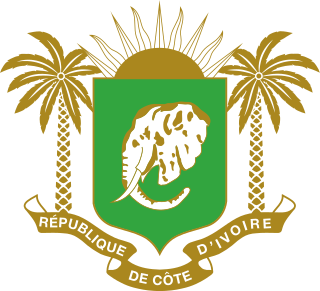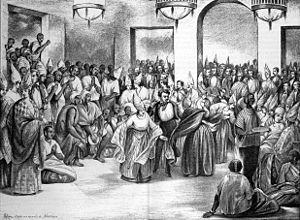
Portuguese Guinea, called the Overseas Province of Guinea from 1951 until 1972 and then State of Guinea from 1972 until 1974, was a West African colony of Portugal from 1588 until 10 September 1974, when it gained independence as Guinea-Bissau.

Casta is a term meaning lineage or race in Spanish and Portuguese. The term has historically been used as a racial and social identifier for mixed-race offspring in the colonial Spanish Empire in the Americas. The Spanish crown created a basic legal division between Hispanic society and Indigenous peoples, mainly living in indigenous communities. In the Hispanic sector were Spaniards, Black Africans, and mixed-race castas.

Île de Gorée is one of the 19 communes d'arrondissement of the city of Dakar, Senegal. It is an 18.2-hectare (45-acre) island located 2 kilometres at sea from the main harbour of Dakar, famous as a destination for people interested in the Atlantic slave trade.
The lançados were settlers and colonizers of Portuguese origin in Senegambia, Cabo Verde, Guinea, Sierra Leone, and other areas on the coast of West Africa. Many were Jews—often New Christians—escaping persecution from the Portuguese Inquisition. Lançados often took African wives from local ruling families, securing protection and advantageous trading ties. They established clandestine trading networks in weaponry, spices, and slaves. This black market angered the Portuguese Crown by disrupting its ability to collect taxes.

The House of Slaves and its Door of No Return is a museum and memorial to the victims of the Atlantic slave trade on Gorée Island, 3 km off the coast of the city of Dakar, Senegal. Its museum, which was opened in 1962 and curated until Boubacar Joseph Ndiaye's death in 2009, is said to memorialise the final exit point of the slaves from Africa. While historians differ on how many African slaves were actually held in this building, as well as the relative importance of Gorée Island as a point on the Atlantic slave trade, visitors from Africa, Europe, and the Americas continue to make it an important place to remember the human toll of African slavery.

The first wave of European colonization began with Spanish and Portuguese conquests and explorations, and primarily involved the European colonization of the Americas, though it also included the establishment of European colonies in India and in Maritime Southeast Asia. During this period, European interests in Africa primarily focused on the establishment of trading posts there, particularly for the African slave trade. The wave ended with the British annexation of the Kingdom of Kandy in 1815 and the founding of the colony of Singapore in 1819.

Slavery in Brazil began long before the first Portuguese settlement. Later, colonists were heavily dependent on indigenous labor during the initial phases of settlement to maintain the subsistence economy, and natives were often captured by expeditions of bandeirantes. The importation of African slaves began midway through the 16th century, but the enslavement of indigenous peoples continued well into the 17th and 18th centuries. Europeans and Chinese were also enslaved.
The French conquest of Senegal started in 1659 with the establishment of Saint-Louis, Senegal, followed by the French capture of the island of Gorée from the Dutch in 1677, but would only become a full-scale campaign in the 19th century.
Anne Pépin (1747–1837) was the richest and most celebrated woman on the West African island of Gorée in French Senegal. Pepin’, born to a European man and African woman, was born into the Afro-European class known as habitants. In 1786, she entered a relationship with the then-governor Stanislas de Boufflers at the same time that he moved the capital of Senegal from Saint Louts to Gorée. Pépin held the designation of signare, a prestigious social and economic designation for women who formed partnerships with European men and, as such, wielded great power. Pépin lived in the “golden age of the habitants, and her life illustrates how this class functioned as an intermediary group in Afro-European relations."

Slavery in Latin America was an economic and social institution that existed in Latin America before the colonial era until its legal abolition in the newly independent states during the 19th century. However, it continued illegally in some regions into the 20th century. Slavery in Latin America began in the pre-colonial period when indigenous civilizations, including the Maya and Aztec, enslaved captives taken in war. After the conquest of Latin America by the Spanish and Portuguese, of the nearly 12 million slaves that were shipped across the Atlantic, over 4 million enslaved Africans were brought to Latin America. Roughly 3.5 million of those slaves were brought to Brazil.
Bibiana Vaz de França was a prominent nhara slave-trader in Cacheu, Guinea-Bissau.
The Prazeiros were the Portuguese and Afro-Portuguese landowners who ruled, in a feudal-like manner, vast estates called prazos that were leased to them by the Portuguese Crown, in the Zambezi Valley from the sixteenth through to the eighteenth century. As a racially hybrid community, the Prazeiros signified not only a merger of cultures, but an emergence of a new socio-political order.
Cassare or calissare was the term applied to the marriage alliances, largely in West Africa, set up between European and African slave traders; the "husband" was European and the wife/concubine African. This was not marriage under Christian auspices, although there might be an African ceremony; there were few clerics in equatorial Africa, and the "wives" could not marry since they had not been baptized. Male monogamy was not expected. As such, concubinage is a more accurate term. The multinational Quaker slave trader and polygamist, Zephaniah Kingsley purchased the Wolof princess, Anna Kingsley, who had earlier been enslaved and sold in Cuba, after being captured in modern-day Senegal.
Anne Rossignol (1730–1810), was a famous signare businesswoman and slave trader. Born on Gorée, she emigrated to Saint-Domingue in 1775, where she became one of the three richest free coloured businesswomen in the colony, alongside Zabeau Bellanton in Cap-Français and Jeanne-Genevieve Deslandes in Port-au-Prince. She emigrated to Charleston, South Carolina during the Haitian Revolution, and has been called the first free African to have emigrated voluntarily and freely to America.
Dame Portugaise, was a Luso-African Nhara slave trader. She was likely daughter of a Portuguese man and African woman and established as a slave trader and merchant in Rufisque, where she acted as a contact channel between the Portuguese and the African rulers of the region through her connections with both, in effect controlling the entire business between the Africans and the Europeans in the region. She is the earliest example of the many Euro-African businesswomen who acted as business-agents and diplomats between the Europeans and the African from this point on until the end of the 19th-century.
Dona Aurelia Correia, also known as Mae Aurelia, Mame Correia Aurelia and Madame Oralia, was a Euro-African nhara slave trader. She was titled "Queen of Orango" by Portuguese and Luso-Africans. Aurelia, a slave trader from West Africa, is believed to have been born from a probable relationship between a trader from Cape Verde and a local woman. She was a dominant key figure in the business life of Guinea-Bissau during the first half of the 19th-century. She is regarded as the most famous of the nhara-community of the region, was regarded as an important member of the community by the Portuguese and described as a powerful businesswoman in oral African tradition. She was the fosterchild and possibly maternal niece of Julia da Silva Cardoso, and the de facto wife of the businessman Caetano José Nozolini (1800-1850), Portuguese governor of Cape Verde. On her mother’s side Correia descended from the Bijagó, the ruling matrilineage on the island of Orango, the largest and most important in the archipelago of the Guinea coast.

Ivorian nationality law is regulated by the Constitution of Ivory Coast, as amended; the Ivorian Nationality Code, and its revisions; and various international agreements to which the country is a signatory. These laws determine who is, or is eligible to be, a national of Ivory Coast. The legal means to acquire nationality, formal legal membership in a nation, differ from the domestic relationship of rights and obligations between a national and the nation, known as citizenship. Nationality describes the relationship of an individual to the state under international law, whereas citizenship is the domestic relationship of an individual within the nation. Ivorian nationality is typically obtained under the principle of jus soli, i.e. by birth in Ivory Coast, or jus sanguinis, i.e. by birth in Ivory Coast or abroad to parents with Ivorian nationality. It can be granted to persons with an affiliation to the country, or to a permanent resident who has lived in the country for a given period of time through naturalization.

São Toméan nationality law is regulated by the Constitution of São Tomé and Príncipe, as amended; the Nationality Law, and its revisions; and various international agreements to which the country is a signatory. These laws determine who is, or is eligible to be, a national of São Tomé and Príncipe. The legal means to acquire nationality, formal legal membership in a nation, differ from the domestic relationship of rights and obligations between a national and the nation, known as citizenship. Nationality describes the relationship of an individual to the state under international law, whereas citizenship is the domestic relationship of an individual within the nation. São Toméan nationality is typically obtained under the principles of jus soli, i.e. by birth in the territory, or jus sanguinis, i.e. by birth in São Tomé and Príncipe or abroad to parents with São Toméan nationality. It can be granted to persons with an affiliation to the country, or to a permanent resident who has lived in the country for a given period of time through naturalization.
Marie Baude (1703-?) was a Senegambian woman who was married to convicted murderer, Jean Pinet. Despite a lack of significant evidence regarding her life, Baude's narrative embodies the intricate dynamics of the transatlantic slave trade era, from her ascent as a signare, wielding influence amid the trade, to the events surrounding her husband's trial and deportation.
![Negresse of quality from the Island of Saint Louis in Senegal, accompanied by her slave, Illustration from Costumes civils de tous les peuples connus, Paris, 1788, by Jacques Grasset de Saint-Sauveur [fr]. Hommes femmes et scenes du Senegal-Jacques Grasset de Saint Sauveur mg 8495.jpg](http://upload.wikimedia.org/wikipedia/commons/thumb/a/a9/Hommes_femmes_et_sc%C3%A8nes_du_S%C3%A9n%C3%A9gal-Jacques_Grasset_de_Saint_Sauveur_mg_8495.jpg/220px-Hommes_femmes_et_sc%C3%A8nes_du_S%C3%A9n%C3%A9gal-Jacques_Grasset_de_Saint_Sauveur_mg_8495.jpg)










